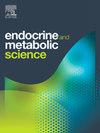Association between dyslipidemia and elevated liver enzymes: A cross-sectional study from the PERSIAN Guilan cohort study
Q3 Medicine
引用次数: 0
Abstract
Background
Dyslipidemia is associated with several health complications that put a heavy burden on the healthcare system and society due to its adverse outcomes. Abnormal lipid profile is known to cause complications in hepatic systems. The aim of this study was to examine the associations of elevated liver enzymes with dyslipidemia and its components in the Prospective Epidemiological Research Studies (PERSIAN) Guilan Cohort study (PGCS) population.
Methods
This cross-sectional study was conducted on data from 10,520 participants in PGCS, Guilan province, Iran. The demographic data and clinical characteristics of the participants were recorded. Lipid profile of the participants, including total cholesterol (Chol), triglycerides (TG), low-density lipoprotein cholesterol (LDL), and high-density lipoprotein cholesterol (HDL); and liver enzymes levels including alanine and aspartate aminotransferase (ALT, AST), γ-glutamyltransferase (GGT) and alkaline phosphatase (ALP) were measured. Statistical analyses were performed using SPSS version 16 based on a significant level < 0.05.
Results
Of 10,520 participants, 53.6 % (n = 5633) were female, and 36.6 % were aged 45–54. The mean BMI of the participants was 28.14 kg/m2. The prevalence of alcohol consumption, fatty liver disease, hepatitis, lipid-lowering medication use, and hepatotoxic drug use were 13.3 %, 0.6 %, 0.3 %, 15.1 %, and 16.5 %, respectively. Abnormal levels of Chol, TG, LDL, HDL, ALT, AST, GGT, and ALP were reported in 40.3 %, 43.1 %, 29.0 %,41.5 %, 19.4 %, 4.6 %, 11.6 %, and 5.1 % individuals, respectively. Dyslipidemia significantly increased the likelihood of elevated ALT, AST, and GGT (P < 0.05), but showed no statistically significant association with elevated ALP (P > 0.05). High Chol, TG, and LDL were strongly associated with elevated liver enzymes, particularly ALT and GGT, while low HDL was less impactful.
Conclusion
These results underscore the significant impact of lipid abnormalities on liver function tests, especially for ALT and GGT.
血脂异常与肝酶升高之间的关系:来自波斯桂兰队列研究的横断面研究
背景:血脂异常与多种健康并发症相关,由于其不良后果,给医疗保健系统和社会带来沉重负担。脂质异常可引起肝系统并发症。本研究的目的是在前瞻性流行病学研究(波斯)桂兰队列研究(PGCS)人群中研究肝酶升高与血脂异常及其组成部分的关系。方法本横断面研究的数据来自伊朗桂兰省PGCS的10,520名参与者。记录参与者的人口学资料和临床特征。参与者的脂质谱,包括总胆固醇(Chol)、甘油三酯(TG)、低密度脂蛋白胆固醇(LDL)和高密度脂蛋白胆固醇(HDL);测定肝酶水平,包括丙氨酸和天冬氨酸转氨酶(ALT、AST)、γ-谷氨酰转移酶(GGT)和碱性磷酸酶(ALP)。采用SPSS version 16进行统计学分析,基于显著水平<;0.05.结果10520名参与者中,53.6% (n = 5633)为女性,36.6%年龄在45-54岁之间。参与者的平均BMI为28.14 kg/m2。饮酒、脂肪肝、肝炎、使用降脂药物和使用肝毒性药物的患病率分别为13.3%、0.6%、0.3%、15.1%和16.5%。胆固醇、TG、LDL、HDL、ALT、AST、GGT和ALP的异常水平分别为40.3%、43.1%、29.0%、41.5%、19.4%、4.6%、11.6%和5.1%。血脂异常显著增加ALT、AST和GGT升高的可能性(P <;0.05),但与ALP升高无统计学意义(P >;0.05)。高胆固醇、TG和LDL与肝酶升高密切相关,尤其是ALT和GGT,而低HDL影响较小。结论脂质异常对肝功能检测,尤其是ALT和GGT检测有显著影响。
本文章由计算机程序翻译,如有差异,请以英文原文为准。
求助全文
约1分钟内获得全文
求助全文
来源期刊

Endocrine and Metabolic Science
Medicine-Endocrinology, Diabetes and Metabolism
CiteScore
2.80
自引率
0.00%
发文量
4
审稿时长
84 days
 求助内容:
求助内容: 应助结果提醒方式:
应助结果提醒方式:


